ATI PN Mental Health Practice 2020 A(latest update)rated A+ already passed!
Document Content and Description Below
A nurse is reinforcing teaching with a client who has schizophrenia and a new prescription for chlorpromazine. Which of the following statements should the nurse include in the teaching? A. "The voic... es you have been hearing should decrease." B. "You will likely have more energy while on this medication." C. "You should now be able to spend more time in the sun." D. "Call your provider immediately if you develop a dry mouth." A. "The voices you have been hearing should decrease." - The nurse should instruct the client that hallucinations and agitated behavior, which are positive symptoms of schizophrenia, are targeted by conventional antipsychotic agents, such as chlorpromazine. A nurse is caring for a client who has bipolar disorder and is experiencing a manic episode. Which of the following interventions should the nurse take first? A. Remove harmful objects from the client's room. B. Decrease the client's environmental stimuli. C. Administer an antipsychotic medication to the client. D. Provide physical activities for the client. A. Remove harmful objects from the client's room. - The greatest risk to this client is self-injury or injury to others. Therefore, the first action the nurse should take is to remove harmful objects from the client's room to protect the client. A nurse is caring for a client who is 2 days postoperative following a hip arthroplasty. When a news report about military action appears on the television, the client says to the nurse, "My youngest child died 6 months ago while serving in the military." Which of the following responses should the nurse make? (SATA) A. "This must be a very difficult time for you." B. "Your child's death must be a terrible loss." C. "It's just awful what is going on in the world." D. "You need to focus on getting better." E. "Tell me something you remember about your child." A, B, E - "This must be a very difficult time for you" is correct.. This statement demonstrates the use of reflecting. Reflecting expresses the nurse's observations of the client's verbal and nonverbal behaviors when discussing sensitive issues. This therapeutic communication technique encourages clients to accept and embrace their own feelings. - "Your child's death must be a terrible loss" is correct. This statement demonstrates the use of reflecting. Reflecting expresses the nurse's observations of the client's verbal and nonverbal behaviors when discussing sensitive issues. This therapeutic communication technique encourages clients to accept and embrace their own feelings. - "Tell me something you remember about your child" is correct. This statement demonstrates the use of exploring. Exploring acknowledges the client's feelings and facilitates communication between the client and the nurse. A nurse is reinforcing teaching with a client who has generalized anxiety disorder and a new prescription for buspirone. Which of the following statements should the nurse identify as an indication that the client understands the information? A. "This medication can cause dependence." B. "I'll take an extra dose of my medication when I start to feel anxious." C. "It's important to take my medication 30 minutes before bedtime." D. "I should expect my symptoms to improve in about 2 to 4 weeks." D. "I should expect my symptoms to improve in about 2 to 4 weeks." - The nurse should instruct the client to expect some improvement of manifestations within approximately 1 week. However, it takes 2 to 4 weeks for buspirone to reach its full effect. A nurse in an inpatient unit is collecting data from a group of clients. Which of the following findings should the nurse report to the provider? A. A client who has schizophrenia is using neologisms. B. A client who has bipolar disorder is experiencing a flight of ideas. C. A client who has depression avoids making eye contact. D. A client who has borderline personality disorder is pacing restlessly. D. A client who has borderline personality disorder is pacing restlessly. - The nurse should identify that a client who has borderline personality disorder and is pacing restlessly is at increased risk for violence towards themselves or others. This behavior should be reported to the provider. A nurse is caring for an adult client who has visible injuries as a result of partner violence. Which of the following actions should the nurse take? A. Insist that the client report the incident to authorities before beginning treatment. B. Encourage the client to develop a safety plan. C. Recommend that the partner remain in the room during the interview with the client. D. Advise the client to obtain an order of protection from the court. B. Encourage the client to develop a safety plan. - The nurse should encourage the client to develop a safety plan to aid in escaping further violence if necessary. A nurse in an inpatient unit is assisting with a group therapy session. During the session, a client begins to shout and use aggressive language. Which of the following statements should the nurse make to the client? A. "Why do you feel the need to speak this way to others in the group?" B. "When you raise your voice, it makes me feel uncomfortable and unsafe." C. "You are frightening others in the group when you show your anger." D. Why are you attending group therapy but not respecting the feelings of others?" B. "When you raise your voice, it makes me feel uncomfortable and unsafe." - Using "I feel" messages models the sharing and owning of personal feelings and helps minimize defensive responses. A nurse is caring for a client who takes naltrexone for the treatment of alcohol use disorder. The nurse should identify that which of the following client statements indicates the medication is effective? A. "Naltrexone calms my nerves." B. "I get flushed when I drink alcohol while taking naltrexone." C. "Naltrexone decreases my fine hand tremors." D. "I drink less alcohol in a day while taking naltrexone." D. "I drink less alcohol in a day while taking naltrexone." - Clients who take naltrexone have a decreased craving for alcohol and experience decreased pleasurable effects from alcohol consumption. Although the goal for most clients who have alcohol use disorder is to maintain abstinence, clients who ingest alcohol while taking this medication often drink less per day. A nurse is reinforcing teaching about expected withdrawal manifestations with a client who has enrolled in a smoking cessation course. Which of the following client statements indicates an understanding of the information? A. "I can expect my cigarette cravings to go away within 7 to 10 days." B. "I will likely feel like my heart is racing even when I'm resting." C. "I should increase my intake of calories because of the expected weight loss." D. "I will probably feel irritable within 24 hours of my last cigarette." D. "I will probably feel irritable within 24 hours of my last cigarette." - The nurse should inform the client that withdrawal manifestations include irritability, craving, and difficulty concentrating. These manifestations typically start within 24 hr of the last cigarette or nicotine use. A nurse is collecting data from a newly admitted client. Which of the following questions should the nurse include to gather psychosocial information? A. "Do you have a hobby that you enjoy?" B. "What is the date and where are you living?" C. "How are an apple and an orange alike?" D. "Can you take this pencil and put it in the cup?" A. "Do you have a hobby that you enjoy?" - The nurse should ask questions regarding the client's interests and hobbies when gathering psychosocial information. A nurse is monitoring the nutritional status of a client who has bulimia nervosa. The nurse should monitor the client for which of the following complications? A. Hyperchloremia B. Hyponatremia C. Decreased bone density D. Increased WBC count B. Hyponatremia - The nurse should monitor clients who have bulimia nervosa for hyponatremia, which results from purging, vomiting, and laxative and/or diuretic use. A nurse is caring for a client who has bipolar disorder. The client suddenly appears agitated and begins pacing at the end of the hallway with clenched fists. Which of the following actions should the nurse take first? A. Call for assistance to place the client in restraints. B. Administer a sedative to the client. C. Determine the client's intentions. D. Place the client into the assigned seclusion room. C. Determine the client's intentions. - The first action the nurse should take when using the nursing process is to collect data from the client. By determining the client's intentions, the nurse can de-escalate the situation by talking to the client in a calm manner. This intervention will assist the nurse in establishing a trusting relationship with the client. A nurse is assisting the charge nurse with the preparation for an in-service about negligence for a group of newly licensed nurses. Which of the following scenarios should the charge nurse use as an example to identify negligence? A. A nurse does not notify the provider of a change in condition for a client who has schizophrenia. B. A nurse delegates an assistive personnel to sit with a client who has bulimia nervosa during mealtimes. C. A nurse administers an anti-anxiety medication to a restless client who has given implied consent. D. A nurse does not document the completion of an incident report about a recent fall in the client's medical record. A. A nurse does not notify the provider of a change in condition for a client who has schizophrenia. - Negligence is the failure to act in a manner which follows the standard of care. The nurse should inform the provider of any changes in a client's condition. Failure to do so is considered negligence. A nurse is contributing to the plan of care for a client who has borderline personality disorder and exhibits manipulative behaviors. Which of the following interventions should the nurse include in the plan to address limit setting? A. Establish and explain consequences for the client's behavior. B. Teach the client to use reaction formation for behavior control. C. Recommend that the client attend assertiveness training. D. Encourage the client to increase socialization. A. Establish and explain consequences for the client's behavior. - The nurse should communicate desired behavior and expectations as well as detailed consequences for not meeting those expectations to a client who has borderline personality disorder. These expectations and consequences should be included in the plan of care when addressing limit setting with the client. A nurse in a mental health facility is caring for a client who is becoming agitated. Which of the following actions should the nurse take first? A. Place the client in seclusion. B. Offer diversionary activities. C. Administer haloperidol. D. Apply wrist restraints. B. Offer diversionary activities. - When providing client care, the nurse should first use the least restrictive intervention. Therefore, the nurse should offer diversionary activities to distract the client and redirect their energy into more appropriate behaviors. A nurse in a provider's office is collecting data from an older adult client whose adult child reports that the client "seems confused and can't seem to remember much." Which of the following findings should lead the nurse to suspect delirium? A. The client's confusion worsens during times of stress. B. The client's level of consciousness changes during the interview. C. The client's confusion improves in the evening. D. The client has a flat affect during the interview. B. The client's level of consciousness changes during the interview. - Delirium can rapidly alter the client's level of consciousness, which can manifest as agitation or stupor. Therefore, the nurse should suspect that this client is experiencing delirium. A nurse in a long-term care center is caring for an adult client who has Alzheimer's disease and whose partner died several years ago. The client appears upset and asks the nurse when their partner will visit again. The nurse states, "It seems like you are feeling lonely. Let's take a walk outside and talk." Which of the following communication strategies is the nurse using? A. Reminiscence therapy B. Feedback C. Validation therapy D. Reflecting C. Validation therapy - The nurse is using validation therapy as a strategy to communicate with the client. This strategy validates the client's feelings and emotions, even when they don't coincide with reality. The nurse should also attempt to integrate redirection techniques without the client realizing they are being redirected. A nurse is caring for an older adult client who is about to undergo screening with the mental status examination (MSE). The client asks about the purpose of this test. Which of the following responses should the nurse make? A. "We're just going to ask you some very simple questions." B. "This test will collect information about your family history." C. "You are going to be okay. There is nothing to worry about." D. "This test will give us information about how you remember things." D. "This test will give us information about how you remember things." - The MSE tests the cognitive function of the client. It is an assessment of the client's current memory, speech, and cognition. A nurse is contributing to the plan of care for a client who has obsessive-compulsive disorder and continually washes their hands. Which of the following interventions should the nurse recommend including in the plan? A. Inform the client that excessive handwashing is a negative behavior. B. Do not allow the client to use a private restroom. C. Schedule times for the client to wash their hands during the day. D. Explain that unit privileges will be taken away if excessive handwashing continues. C. Schedule times for the client to wash their hands during the day. - Providing a schedule is a type of response prevention and can decrease anxiety by allowing the client to know in advance when handwashing can be performed. A nurse is caring for a client who have birth to a stillborn fetus 1 week ago. The client states to the nurse, "I am so angry that my doctor didn't take better care of me and my baby." Which of the following responses should the nurse make? A. "You should concentrate on feeling better. You've been through a lot." B. "You should begin to accept what happened, so you can work through your loss." C. "It is important to share what you are feeling, even if it is anger." D. "Everyone experiences anger at first. This will pass over time." C. "It is important to share what you are feeling, even if it is anger." - The nurse is encouraging the client to discuss their perception of the loss, which is a therapeutic communication technique. It is helpful to acknowledge that anger is an expected reaction to loss and encourage the client to verbalize their feelings. A nurse is speaking with a client who is expressing an intense disapproval of the current social worker. When the social worker approaches the nurse and client a few moments later, the client cheerfully states, "Now, here is my favorite social worker!" The nurse should identify that the client is using which of the following defense mechanisms? A. Reaction formation B. Dissociation C. Denial D. Projection A. Reaction formation - The nurse should identify that this client is using reaction formation. This is the defense mechanism in which the client is unable to process unacceptable feelings or behaviors and expresses the opposite to decrease anxiety. Dissociation [Show More]
Last updated: 2 years ago
Preview 1 out of 15 pages
rated A+ already passed!.png)
Buy this document to get the full access instantly
Instant Download Access after purchase
Buy NowInstant download
We Accept:

Reviews( 0 )
$17.00
Can't find what you want? Try our AI powered Search
Document information
Connected school, study & course
About the document
Uploaded On
Feb 07, 2023
Number of pages
15
Written in
Additional information
This document has been written for:
Uploaded
Feb 07, 2023
Downloads
0
Views
106
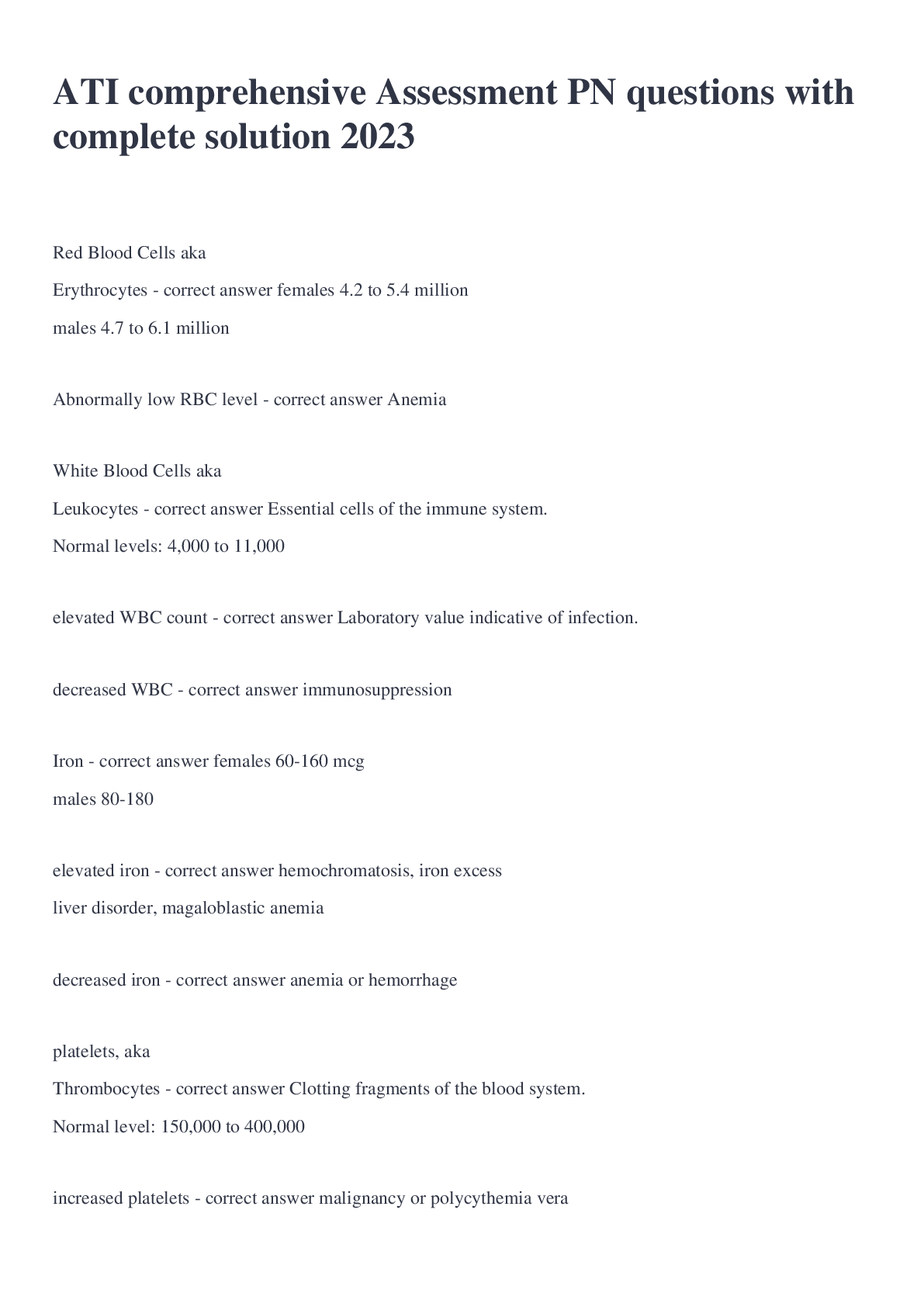




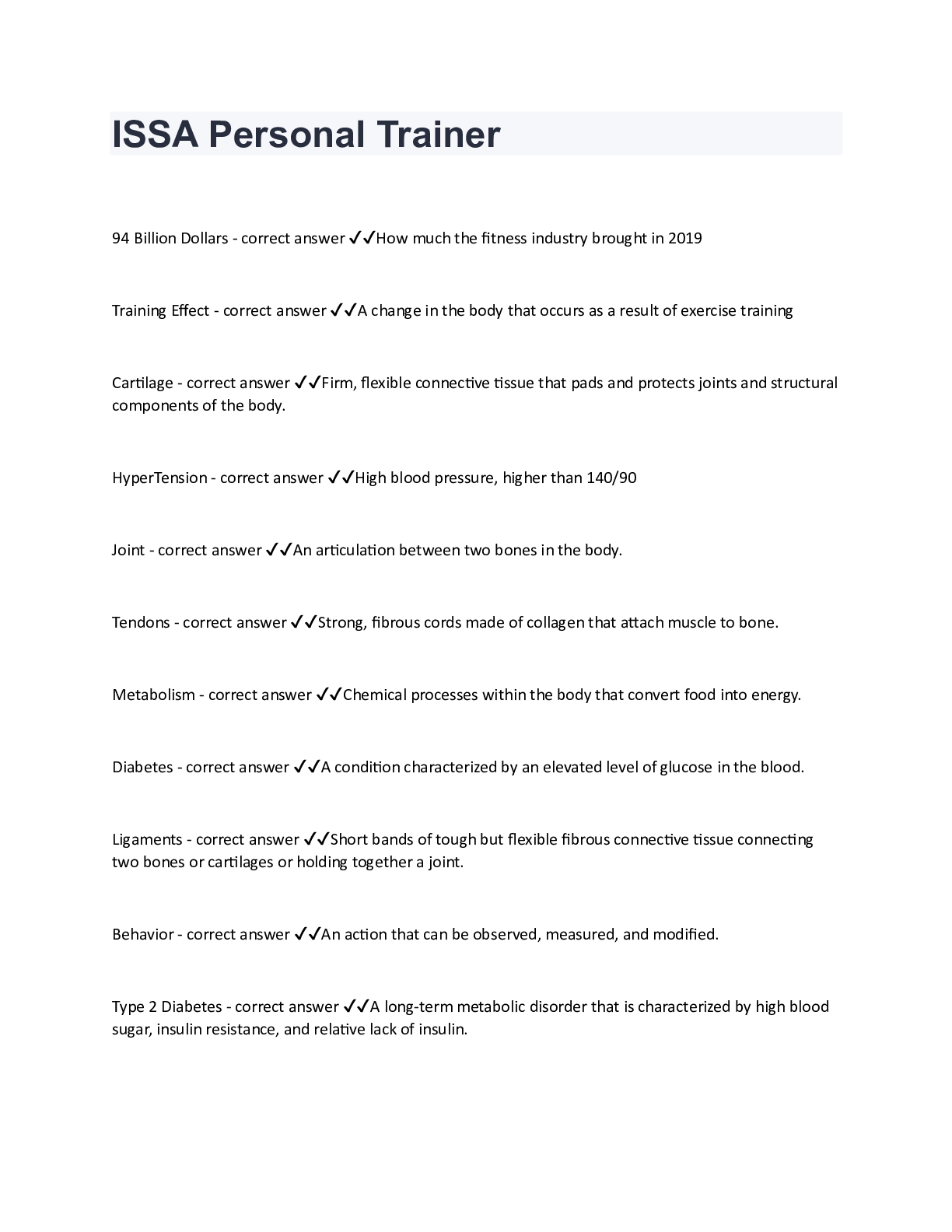
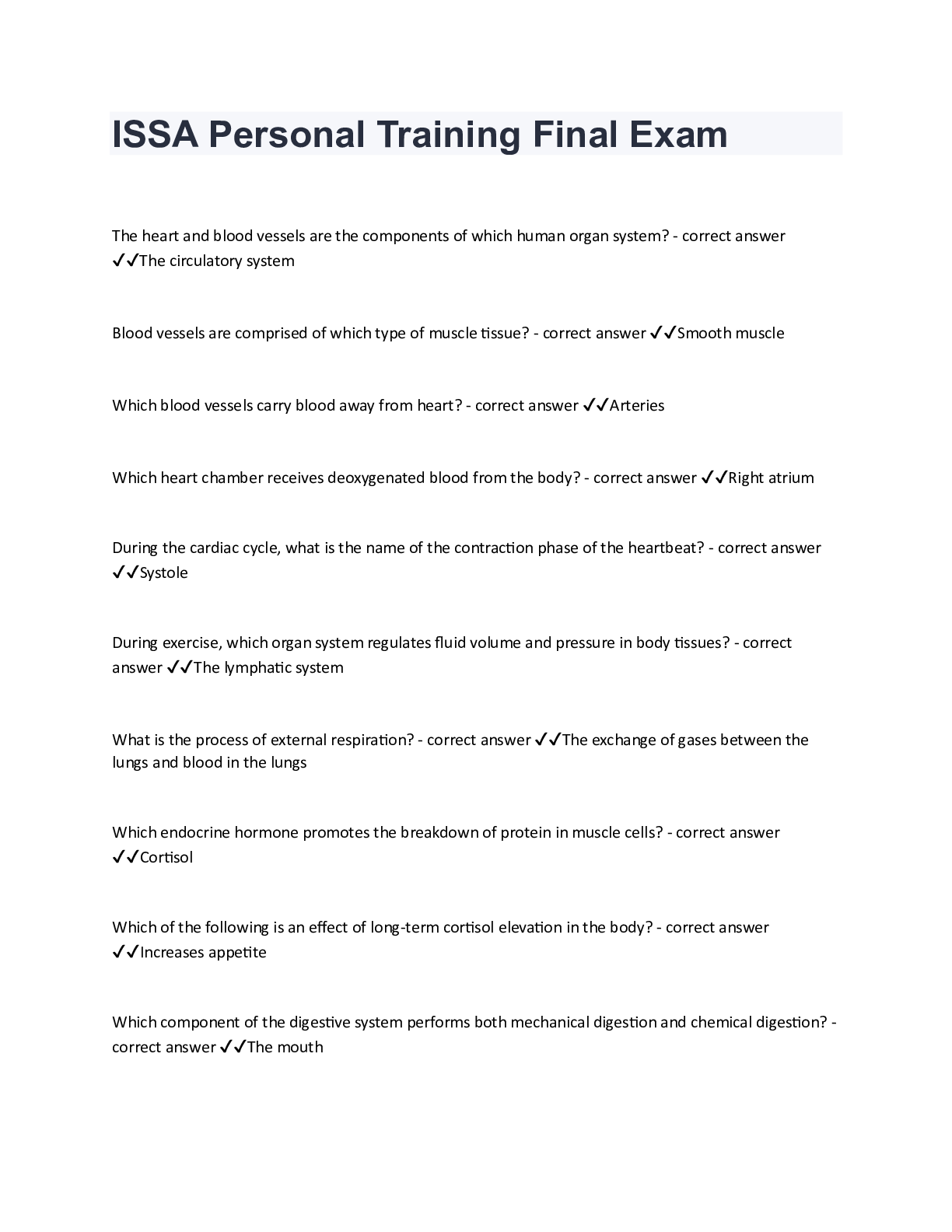

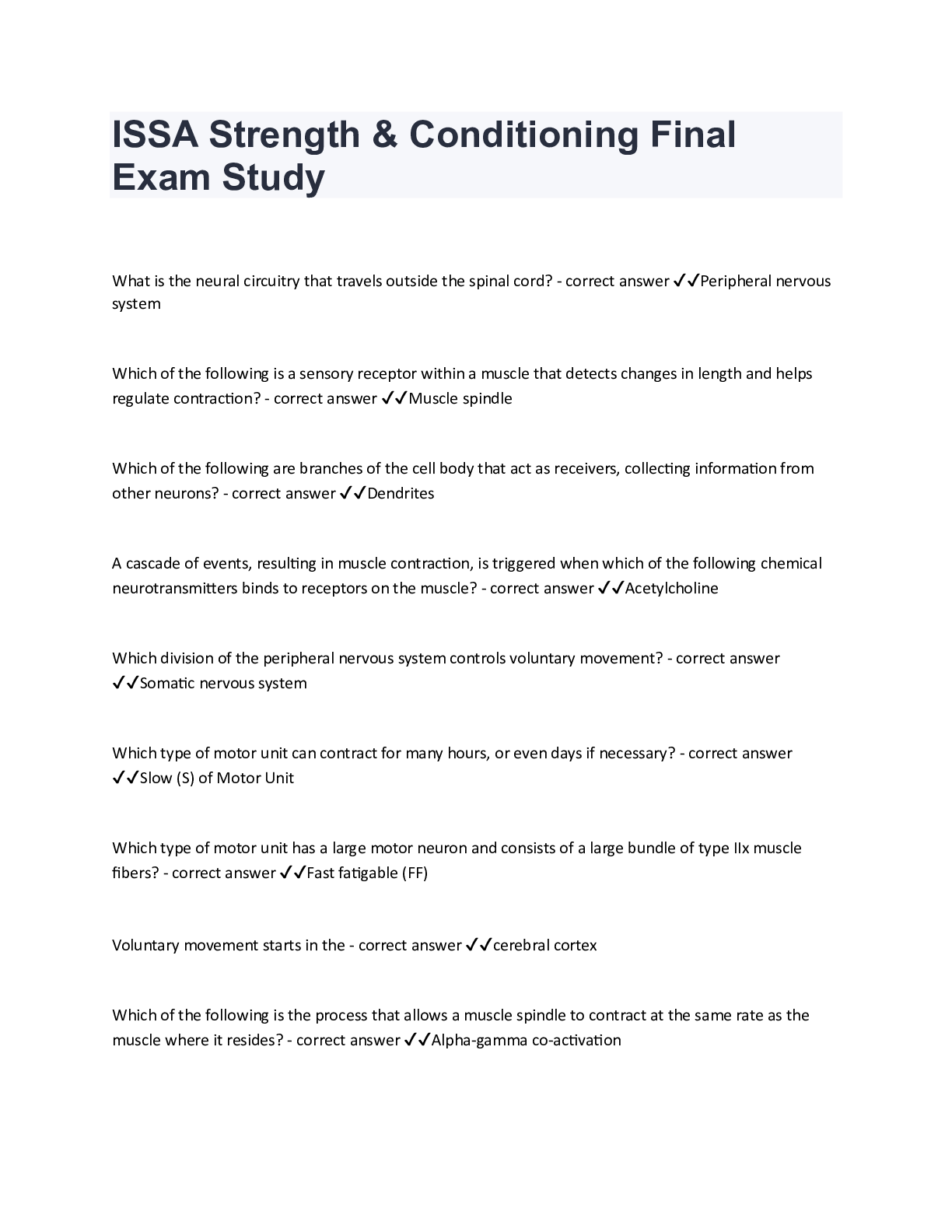

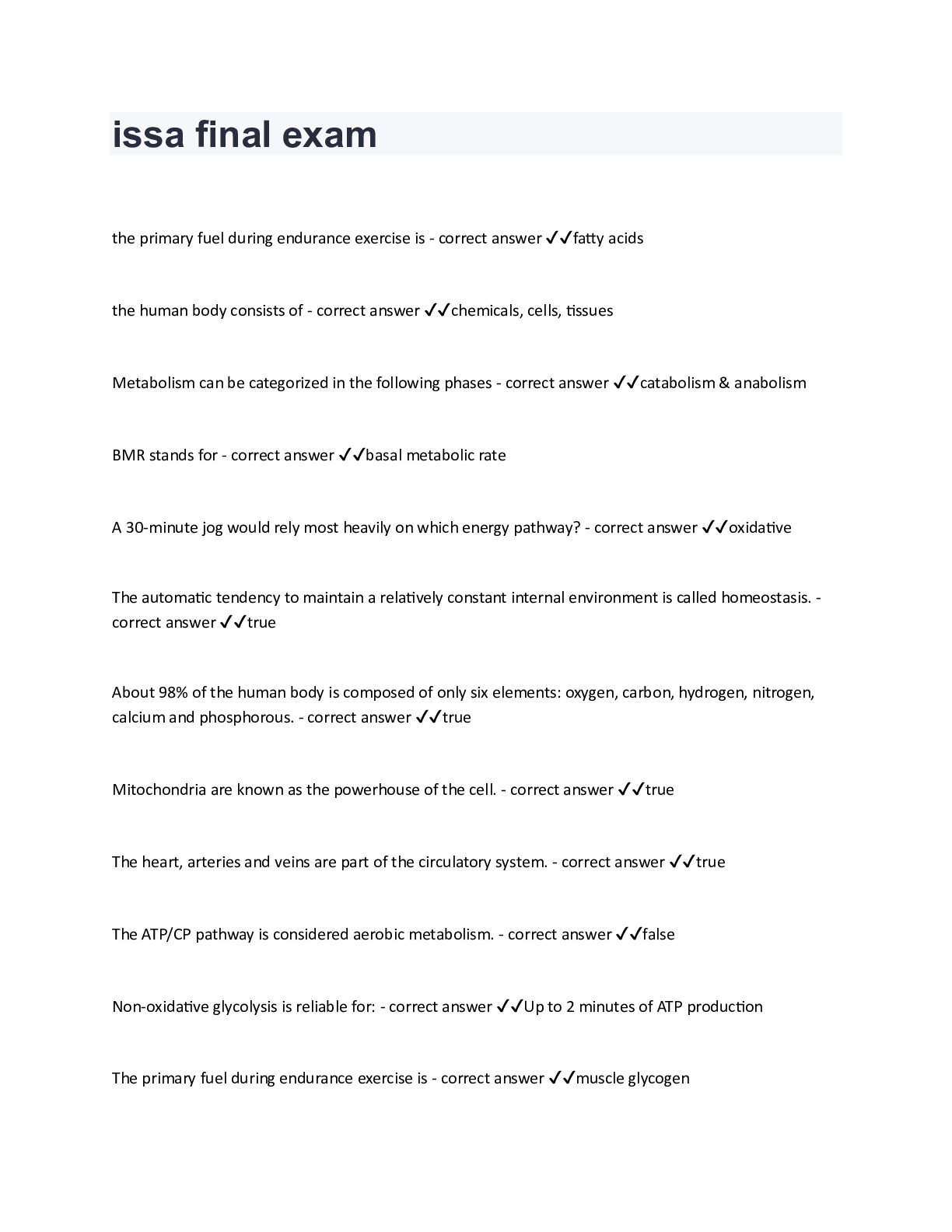







.png)






